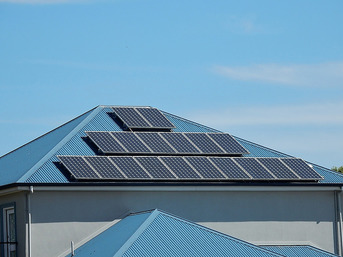|
Solar power can be divided into two broad types of systems. You can either have a off the grid system that is not connected to the electrical grid or you can have a grid tied system where you generate power but are still tied the electrical system. Each method has its own pros and cons which I shall endeavor to lay out in the following post.  Grid Tied Systems Many terms are used to describe grid connected systems and they include on grid, grid-tied, utility-interactive, etc. Lower equipment and installation costs are typical with grid connected systems as they can have higher efficiency rates and in many locations net metering with utilities. Grid connected systems are cheaper and simpler to install because they do not need any batteries and other stand-alone equipment like off-grid systems. Solar panels will often generate surplus energy and with a grid connected systems you can add green renewable energy into the utility grid. Grid tied solar systems however are still totally dependent on the grid so when it loses power from a down line or a storm you will lose power too. The Grid You can’t really discuss grid tied solar systems without a little blurb on the grid itself. Electricity itself is not a power source but rather a power carrier. Electricity is primarily generated at central power plants using steam driven turbines. The steam is generated by the combustion of typically some sort of fossil fuel like coal, oil or natural gas. From the point of creation to distribution there is typically only a loss of around 6% of the power generated. When you store energy in batteries around 5-15% of the energy will drain within the 24 hours. With that in mind the electric power grid is like a very efficient virtual battery and as a result grid connected systems can have higher efficiency rates and there is no need for any replacement of batteries or associated equipment. Off Grid Solar Systems Off grid solar systems or stand-alone systems make use of battery storage and backup generator to ensure steady access to electricity with the average of lifespan of the batteries of around 10 years. These types of solar systems can be cheaper than grid tied ones if you have to extend conventional power lines more than 100 yards away from existing lines. The cost and environmental impact involved with extending overhead transmission lines be extremely high when every factor is taken into account. Energy Self Sufficiency The obvious upside to off the grid systems is energy self-sufficiency and these types of systems can offer a sense of security for the users. You do not need to worry about power failures in the utility grid since you are completely independent from it. But batteries can store only a specific amount of energy and to be really safe you need to install a backup generator to help the solar panels out every now and then. Equipment for Off Grid Systems You need different types of equipment for installing off grid systems and they include solar charger controller, DC disconnects, battery banks, off-grid inverter and backup generator as well. The solar charger controls the amount of electricity being transferred into the battery bank which protects the batteries from overcharging. Obviously you need batteries and their are many different types out there so I will not dive into that in this particular post. Charge inverters are used to the take the DC power generated by the panels and turn it into standard 120 volt AC for your house. You will also have a assortment of disconnect switches to cut off electrical power from flowing into different parts of the solar system. Off Grid vs Grid Connected Systems? Grid connected systems can less expensive to install at homes and many people have used these types of systems to reduce their electric bill, contribute green power to the grid and maybe make some money. On the other hand; when there is power failure, you do not have access to electricity but on cloudy days when your panels are not producing as much you won’t even notice the difference. Off grid systems offer energy independence from the grid which is great when the power lines are down. But if the system hasn’t been sized appropriately you can find yourself with not enough power on extended cloudy days or during bad weather. Both these solar systems have their own advantages and disadvantages and several factors should be taken into consideration including location, climate and budget before deciding whether or not to be on or off the grid. The bottom line is that you need to take into consideration your own needs and do what works the best for you. Sources 1) http://solarsimplified.org/connecting-to-the-grid/ongrid-offgrid 2) http://www.motherearthnews.com/green-homes/off-grid-grid-tied-zbcz1305.aspx 3) http://energyinformative.org/grid-tied-off-grid-and-hybrid-solar-systems/ 4) https://www.eia.gov/tools/faqs/faq.cfm?id=105&t=3 5) http://www.batteryeducation.com/2006/04/battery_degrada.html
1 Comment
5/11/2016 09:16:10 pm
I really like the information provided in this article about Off Grid vs Grid Connected. And I really like the way you have explained each and everything so well. Very well done with the article. hope that you will continue to do posting. thanks
Reply
Leave a Reply. |
AuthorHello my name is Josh Larson and I am the creator of the Green Living Library. Here on the blog you will find updates to content found in the Green Living Library as well as stories from those living the sustainable life already. Archives
December 2021
Categories
All
|